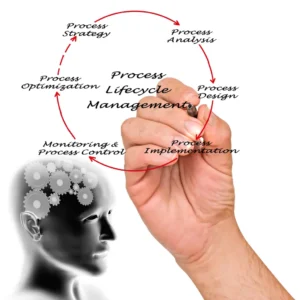
Securing Tomorrow
Strategies for Addressing Security Concerns in AI-Driven Process Automation
In the rapidly evolving landscape of AI-driven process automation, where technological advancements promise efficiency and innovation, the paramount concern remains the robust security of these intricate systems.
As businesses and technical solution providers increasingly integrate artificial intelligence into their processes, the imperative to address security concerns becomes more pronounced.
This article delves into key strategies and practices for fortifying the security of AI-driven processes. Each facet is pivotal in mitigating risks, from data encryption and access control to secure development practices and vigilant monitoring.
As we navigate the intricacies of AI integration, the spotlight on security becomes not just a safeguarding measure but an indispensable element ensuring the trustworthiness and reliability of AI-driven processes.
Table of Contents

Arindam Roy
An Automation Consultant with 25+ years of IT Experience
Data Encryption
In the realm of AI-driven process automation, robust security measures are paramount. One crucial aspect is data encryption.
Data Encryption: Safeguarding Information
In today’s digital landscape, securing sensitive data is non-negotiable. End-to-End Encryption (E2EE) emerges as a stalwart solution. By deploying potent encryption algorithms, data remains shielded across its entire journey — from storage and transmission to processing.
Why E2EE Matters:
- Complete Lifecycle Protection: Are you looking for a foolproof way to secure your business data? Look no further than end-to-end encryption (E2EE). This powerful tool ensures your information is protected at every step, giving you peace of mind and allowing you to focus on what matters – growing your business.
- Exclusive Access: Only authorized entities hold the key to decipher encrypted data. This stringent control ensures data integrity and confidentiality.
Tokenization: Heightening Security
Another pivotal strategy is tokenization. This involves substituting sensitive data with unique tokens, a game-changer in risk reduction. Particularly beneficial for handling payment information or personally identifiable data (PII), tokenization minimizes the threat of data exposure.
Tokenization Advantages:
- Risk Mitigation: Replacing sensitive data with tokens significantly reduces the risk of data exposure and provides a proactive defence against potential breaches.
- Payment and PII Protection: Tokenization proves highly effective in sectors dealing with payment transactions or sensitive personal information, fortifying security protocols.
In the ever-evolving landscape of AI-driven processes, implementing E2EE and tokenization is a pivotal defence, assuring businesses and technical solution providers that their data remains secure and impervious to unauthorized access.
Access Control
Security in AI processes demands precision. Access Control is pivotal in safeguarding sensitive information.
Role-Based Access Control (RBAC): Tailored Security
Implementing Role-Based Access Control (RBAC) can be a game-changer when it comes to access control. This approach allows organizations to finely tune access privileges based on user roles, ensuring that each individual can only access the resources essential to their work. By doing so, it minimizes unauthorized access risks and improves security posture. In other words, RBAC is a powerful tool for organizations that want to take control of their access management and achieve higher precision and security.
RBAC Benefits:
- Focused Access: RBAC ensures users access only resources vital to their roles, minimizing the scope for unwarranted data exposure.
- Risk Reduction: By tailoring access, RBAC minimizes the potential for misuse, reinforcing security and compliance measures.
Attribute-Based Access Control (ABAC): Nuanced Access Management
Taking access control a step further is ABAC. It factors in diverse attributes—user specifics, environment conditions, and resource characteristics—for meticulous access control.
ABAC’s Precision:
- Fine-Grained Control: ABAC’s consideration of multiple attributes allows for detailed, nuanced access control, enhancing overall security posture.
- Adaptive Security: ABAC adapts to dynamic scenarios, aligning access permissions with varying conditions, ensuring a dynamic and robust security framework.
In the dynamic field of AI-driven automation, adopting RBAC and ABAC ensures control and tailored precision, fortifying systems against unauthorized access and potential security breaches.
Data Integrity
Ensuring data integrity is paramount in the landscape of AI-driven process automation.
Digital Signatures: Preserving Authenticity
In critical transactions or with sensitive information, digital signatures emerge as safeguarding sentinels. They verify data authenticity and integrity, ensuring it remains untampered.
Why Digital Signatures Matter:
- Tamper-Proof Assurance: Digital signatures provide an unassailable layer of security, assuring that data remains unaltered during transactions.
- Authenticity Verification: Crucial for sensitive data, digital signatures authenticate the origin, ensuring trustworthiness in AI-driven processes.
In the security-conscious realm of AI-driven automation, using digital signatures isn’t just a precaution; it’s an imperative measure, safeguarding against data tampering and upholding the integrity of vital information.
Monitoring and Logging
Vigilant monitoring and logging are keystones in fortifying security within AI-driven processes.
Real-time Monitoring: Swift Incident Response
In the security landscape, real-time monitoring is a sentinel. It swiftly detects and responds to AI process security incidents.
Real-time Monitoring Benefits:
- Prompt Detection: Real-time monitoring acts as an early warning system, swiftly identifying and responding to security threats.
- User and System Oversight: It monitors user activities and system behaviours, ensuring a comprehensive security outlook.
Logging: Chronicles for Insightful Security
Maintaining detailed logs is imperative. These logs, covering user actions, data access, and model predictions, aid in forensic analysis and offer insights into potential security incidents.
Logging’s Significance:
- Forensic Analysis: Comprehensive logs serve as a forensic trail, crucial for post-incident analysis and understanding the sequence of events.
- Insightful Security: Logs provide insights into patterns, facilitating proactive security measures and continuous improvement in AI-driven processes.
In the stringent landscape of AI-driven automation, real-time monitoring and meticulous logging aren’t just practices; they are indispensable shields against potential security breaches, ensuring a resilient and secure environment.
Regular Security Training
Education is a linchpin in securing AI processes, primarily through regular security training for involved employees.
Employee Training: Fortifying the Human Element
In the stringent landscape of AI-driven automation, the human element is pivotal. Regular security training sessions empower employees.
Training Impact:
- Awareness Elevation: Training cultivates a heightened awareness of security best practices, fostering a proactive security mindset among employees.
- Prepared Workforce: A well-trained workforce can handle security challenges, reducing the risk of accidental security breaches.
In the formalities of AI-driven process automation, the significance of employee training reverberates. Imagine having a workforce ready to face any security challenge with a proactive approach and a constant sense of vigilance. This ensures your organization’s safety and gives you peace of mind, knowing your team is always prepared.
Incident Response Plan
Developing an incident response plan is crucial for swift and effective action during a security breach. Your plan should include:
- Detailed procedures for identifying and containing the breach.
- Notifying relevant parties.
- Restoring your systems to regular operation.
It’s also important to regularly review and update your plan to ensure it remains adequate and relevant to your organization’s needs. Remember, taking proactive measures can help minimize the impact of a security incident and protect your valuable assets.
Develop a Response Plan: Proactive Preparedness
In the security-conscious arena of AI-driven process automation, a meticulously crafted incident response plan is paramount.
Plan Components:
- Communication Strategies: Clearly defined communication ensures a coordinated response, reducing confusion during security incidents.
- Containment Measures: Swift containment is crucial. The plan should promptly outline actions to limit the impact of a security breach.
- System Recovery Steps: Documenting recovery steps is vital for restoring normalcy post-incident, minimizing downtime, and mitigating potential damages.
Crafting an incident response plan is not just a formality; it’s a proactive strategy, ensuring readiness and efficiency in addressing security breaches within AI-driven processes.
Vendor Security Assessment
Outsourcing AI solutions? Prioritize security. Assess third-party vendors to ensure data safeguarding aligns with industry standards.
Assess Third-Party Vendors: Fortifying Alliances
In the meticulous landscape of AI-driven process automation, third-party vendor assessment is non-negotiable.
Why Assessment Matters:
- Data Security Assurance: Vendors adhering to industry standards ensure robust data security, safeguarding against potential vulnerabilities.
- Best Practices Alignment: Ensuring vendors follow best practices fortifies alliances, minimizing the risk of security compromises in AI processes.
In the formalities of AI-driven automation, a vigilant vendor assessment is a strategic safeguard, affirming that collaborative efforts prioritize data security and adhere to industry benchmarks.
Conclusion
In conclusion, the landscape of AI-driven process automation demands a meticulous approach to security, and addressing these concerns is not merely a matter of compliance but a strategic imperative. The comprehensive strategies outlined in this discourse underscore the importance of a proactive stance in fortifying AI systems against potential threats.
Robust data encryption techniques like End-to-End Encryption and Tokenization and precision in access control through Role-Based Access Control (RBAC) and Attribute-Based Access Control (ABAC) serve as sentinels against unauthorized access and data exposure. Regular code reviews and secure coding standards establish a secure AI infrastructure.
Vigilant monitoring, logging, and a well-orchestrated incident response plan provide the tools for swift detection, response, and recovery in the face of security incidents. Moreover, prioritizing employee training ensures that the human element remains a proactive defence against potential vulnerabilities.
Lastly, a meticulous vendor security assessment becomes paramount when leveraging third-party solutions, ensuring collaborative efforts align with industry standards and best practices.
In this era of technological innovation, the commitment to addressing security concerns is not only a responsibility but an essential component of fostering trust, resilience, and longevity in AI-driven process automation.
Related Articles
- Training and Upskilling for AI-Enabled Workforce for IPA
- Challenges in Successful Implementations of AI Tools for IPA
- Addressing Security Concerns in AI-Driven Process Automation
- Integrating AI Tools with Existing Systems for IPA
- Selecting the Right AI Tools for Your Business
- Key Features of AI Tools for IPA: Transforming Processes
- AI Tools for IPA: Revolutionizing Business Efficiency
- Benefits of Implementing AI Tools for IPA
- Understanding the Business Context of IPA
- Evolution of AI in IPA: From Rules to Industry 4.0






















